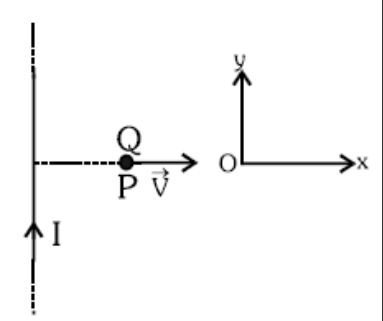When a wire carries a current of 1.20A, the drift velocity is 1.20×10−4m/s. What is the velocity when the current is 6.00A?
The correct Answer is:A, D
To solve the problem, we need to understand the relationship between current (I) and drift velocity (Vd) in a wire. The formula that relates these quantities is:
I=n⋅e⋅A⋅Vd
Where:
- I is the current,
- n is the number density of charge carriers,
- e is the charge of an electron,
- A is the cross-sectional area of the wire,
- Vd is the drift velocity.
From this equation, we can see that the current is directly proportional to the drift velocity, assuming that n, e, and A remain constant.
1. Identify the relationship between current and drift velocity:
Since I∝Vd, we can express this relationship as:
I1I2=Vd1Vd2
where I1 and Vd1 are the current and drift velocity for the first case, and I2 and Vd2 are for the second case.
2. Substitute the known values:
We know:
- I1=1.20A
- Vd1=1.20×10−4m/s
- I2=6.00A
We need to find Vd2:
1.206.00=1.20×10−4Vd2
3. Cross-multiply to solve for Vd2:
1.20⋅Vd2=6.00⋅(1.20×10−4)
Vd2=6.00⋅(1.20×10−4)1.20
4. Simplify the equation:
The 1.20 in the numerator and denominator cancels out:
Vd2=6.00×10−4m/s
5. Final Answer:
The drift velocity when the current is 6.00A is:
Vd2=6.00×10−4m/s
- I is the current,
- n is the number density of charge carriers,
- e is the charge of an electron,
- A is the cross-sectional area of the wire,
- Vd is the drift velocity.
Since I∝Vd, we can express this relationship as:
I1I2=Vd1Vd2
where I1 and Vd1 are the current and drift velocity for the first case, and I2 and Vd2 are for the second case.
We know:
- I1=1.20A
- Vd1=1.20×10−4m/s
- I2=6.00A
1.206.00=1.20×10−4Vd2
1.20⋅Vd2=6.00⋅(1.20×10−4)
Vd2=6.00⋅(1.20×10−4)1.20
The 1.20 in the numerator and denominator cancels out:
Vd2=6.00×10−4m/s
The drift velocity when the current is 6.00A is:
Vd2=6.00×10−4m/s
Topper's Solved these Questions
- CURRENT ELECTRICITYBOOK - DC PANDEY ENGLISHCHAPTER - CURRENT ELECTRICITYEXERCISE - Exercise 23.4
4 Videos
- CURRENT ELECTRICITYBOOK - DC PANDEY ENGLISHCHAPTER - CURRENT ELECTRICITYEXERCISE - Exercise 23.5
2 Videos
- CURRENT ELECTRICITYBOOK - DC PANDEY ENGLISHCHAPTER - CURRENT ELECTRICITYEXERCISE - Exercise 23.2
1 Video
- COMMUNICATION SYSTEMBOOK - DC PANDEY ENGLISHCHAPTER - COMMUNICATION SYSTEMEXERCISE - Subjective
11 Videos
- ELECTROMAGNETIC INDUCTIONBOOK - DC PANDEY ENGLISHCHAPTER - ELECTROMAGNETIC INDUCTIONEXERCISE - Medical entrances gallery
25 Videos
Similar Questions
When current is 4 A in a conductor the drift velocity is vd. When the current is 3 A the drift velocity will be
View SolutionTwo straight infinitely long and thin parallel wires are spaced 0.1m apart and carry a current of 10A each. Find the magnetic field at a point distance 0.1m from both wires in the two cases when the currents are in the (a) same and (b) opposite directions.
View SolutionA copper wire has a square cross-section, 2.0 mm on a side. It carries a current of 8 A and the density of free electrons is 8×1028m−3. The drift speed of electrons is equal to
View SolutionA conductor wire having 1029 free electrons /m3 carries a current of 20A. If the cross-section of the wire is 1mm2, then the drift velocity of electrons will be :
View SolutionA straight wire carries a current of 10A. An electron moving at 103 m/s is at distance 2.0 cm from the wire. Find the force acting on the electron if its velocity is directed toward the wire?
View SolutionTwo long, straight, parallel wires are 1.00m apart (as shown in Fig). The upper wire carries a current I1 of 6.00A into the plane of the paper.

What is the magnitude of the net field at S?
View SolutionTwo long, straight, parallel wires are 1.00m apart (as shown in Fig). The upper wire carries a current I1 of 6.00A into the plane of the paper.

What is the magnitude of the net field at Q?
View SolutionTwo long, straight, parallel wires are 1.00m apart (as shown in Fig). The upper wire carries a current I1 of 6.00A into the plane of the paper.

What must the magnitude of the current I2 be for the net field at point P to be zero?
View SolutionA very long straight wire carries a current I. At the instant when a charge +Q at point P has velocity→V, as shown, the force on the charge is-

View SolutionA very long straight wire carries a current I. At the instant when a charge +Q at point P has velocity →V, as shown, the force on the charge is

View Solution
